Welcome to our exploration of Salvinia Cucullata, a mesmerizing aquatic fern that brings a touch of serenity to water surfaces.
In this article, we will dive into the unique characteristics of Salvinia Cucullata, exploring its floating mechanism, adaptive features, and photosynthetic processes.
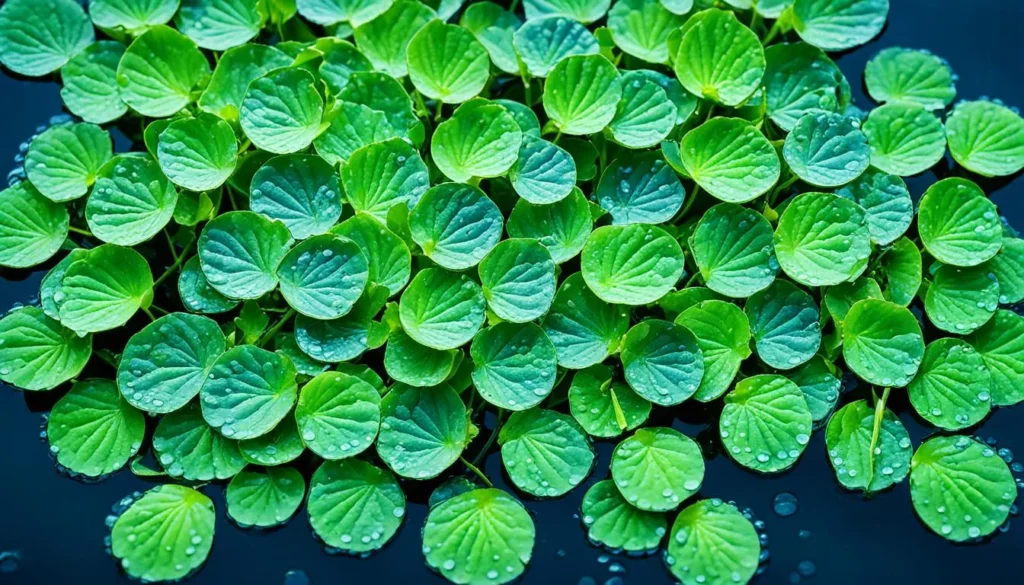
We will also discuss the dual role it plays in aquatic ecosystems, the challenges it presents as an invasive species, cultivation and control methods, propagation techniques, and its role in designing beautiful aquascaping layouts.
Additionally, we’ll touch upon conservation strategies for endangered aquatic species, highlighting the beauty and importance of Salvinia Cucullata.
Key Takeaway
- Salvinia Cucullata is a captivating floating plant with unique adaptive features.
- It plays a dual role in aquatic ecosystems, providing benefits and posing challenges as an invasive species.
- Cultivation and control methods are essential to manage its spread and preserve native habitats.
- Salvinia Cucullata can be propagated naturally through spore release or artificially through controlled techniques.
- Incorporating Salvinia Cucullata in aquascaping layouts can enhance the visual appeal of aquariums or ponds.
Quick Stats
| Attribute | Details |
| Family Name | Salviniaceae |
| Origin | Asia, particularly Southeast Asia |
| Height | Floating on the water surface |
| pH Range | 6.0 – 7.5 |
| CO2 Requirement | Low |
| Growth Rate | Fast |
| Care Level | Easy |
| Color Form | Green |
| Water Conditions | 20-28°C (68-82°F), adaptable to a wide range of water hardness |
| Max Size | Can spread indefinitely, but individual plants remain small |
| Lighting | Low to Moderate |
| Supplements | Minimal; benefits from nutrient-rich water |
| Placement | Floating |
| Propagation | Reproduces rapidly through division of daughter plants |
What Is Salvinia Cucullata?
Salvinia Cucullata, commonly known as waterweed or floating fern, is an aquatic plant belonging to Salviniaceae. It is characterized by its floating leaves with two distinct parts – an egg-shaped floating leaf on the top and a finely dissected submerged leaf below. It is native to various regions around the world, including North America, South America, Africa, and Asia. Its unique and visually appealing appearance has gained popularity in the aquarium trade.
History And Habitat
Salvinia Cucullata has a rich history and is believed to have originated in tropical and subtropical regions.
This aquatic fern can be found in a variety of aquatic environments, including lakes, ponds, rivers, and marshes.
It thrives in still or slow-moving water with high nutrient content, making it a common sight in eutrophic conditions where excess nutrients promote rapid plant growth.
Salvinia Cucullata’s presence in aquatic environments serves as an indicator of the ecological health of the habitat.
While it is native to certain regions, it has also become an invasive species in many areas, disrupting native ecosystems and causing ecological imbalances.

Physical Characteristics
- Leaf Structure: The most distinctive feature of Salvinia cucullata is its leaf structure. Each individual plant consists of two types of leaves: submerged and floating. The submerged leaves are finely divided, feathery, and act as root structures. The floating leaves are broader, oval-shaped, and have a distinct hood-like structure, giving the plant its common name “hooded mosquitofern.”
- Size: They typically range in size from a few centimeters to several centimeters in diameter. The floating leaves can vary in size but are generally smaller than the submerged leaves. The size of the plants can vary depending on factors such as water conditions and nutrient availability.
- Coloration: The coloration of leaves can vary depending on environmental factors. Under optimal conditions, the leaves may exhibit vibrant green coloration. However, under stress or nutrient deficiencies, the leaves may turn yellowish or brownish in color.
- Roots: They have fine, hair-like roots that extend from the submerged leaves into the water column. These roots absorb nutrients and anchor the plants in place. Unlike some other floating plants, such as water lettuce (Pistia stratiotes), Salvinia cucullata does not have long,
Lighting Needs
- Indirect Light: Salvinia cucullata does best when provided with indirect or diffused lighting rather than direct, intense light. Placing the plant in areas where it receives gentle, filtered light is ideal. This can help prevent excessive heat and potential damage to the delicate foliage.
- Avoiding High Intensity Light: While Salvinia cucullata can tolerate moderate light levels, it may struggle or show signs of stress if exposed to high-intensity lighting for prolonged periods. Direct sunlight or intense artificial lighting can cause the leaves to yellow, brown, or become scorched. Therefore, it’s essential to provide moderate or low-intensity lighting to avoid this issue.
- Adaptable to Low Light: Salvinia cucullata is relatively adaptable and can tolerate low light conditions. In aquariums or ponds with lower light levels, the plant may grow more slowly but can still thrive given proper care and nutrient availability.
- Balanced Spectrum: Providing a balanced spectrum of light, similar to natural daylight, is beneficial for them. Full spectrum LED lights or daylight spectrum fluorescent lights are suitable options for aquariums and indoor setups, as they provide the necessary wavelengths for photosynthesis and plant growth.
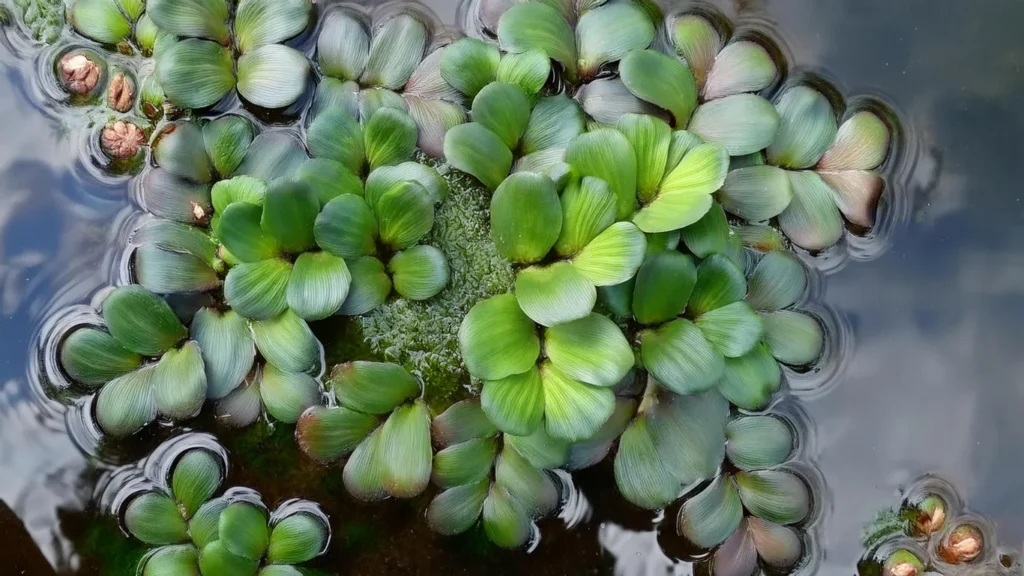
Temperature Parameters
- Temperature Range: Salvinia cucullata typically thrives in tropical to subtropical temperatures. The optimal temperature range for its growth is between 20°C to 30°C (68°F to 86°F). Within this range, the plant tends to grow vigorously and remain healthy.
- Tolerance to Fluctuations: Salvinia cucullata can tolerate minor fluctuations in temperature, but it’s essential to avoid sudden or extreme changes. Rapid fluctuations or prolonged exposure to temperatures outside the optimal range can stress the plant and affect its growth and overall health.
- Winter Considerations: In colder climates or during winter months, Salvinia cucullata may experience slower growth or dormancy if exposed to cooler temperatures. Providing stable temperatures within the optimal range or slightly above can help maintain the plant’s health during colder periods.
- Aquarium Heating: In aquariums, using a reliable aquarium heater can help maintain stable water temperatures within the desired range for Salvinia cucullata. Ensure that the heater is appropriately sized for the aquarium volume and monitor temperature regularly to prevent fluctuations.
Optimal Water Condition
- Temperature: Salvinia cucullata thrives in tropical to subtropical temperatures. The optimal temperature range for its growth is between 20°C to 30°C (68°F to 86°F). Within this range, the plant grows vigorously and remains healthy.
- pH Level: Salvinia cucullata can tolerate a wide range of pH levels, but it typically prefers slightly acidic to slightly alkaline conditions. Aim for a pH range between 6.5 to 7.5 for optimal growth. Fluctuations within this range are generally well-tolerated, but extreme pH levels should be avoided.
- Water Hardness: Salvinia cucullata is adaptable to varying degrees of water hardness (GH and KH). It can tolerate both soft and moderately hard water conditions. Aim for a general hardness (GH) of 4 to 15 dGH and a carbonate hardness (KH) of 3 to 8 dKH.
- Nutrient Levels: Salvinia cucullata benefits from moderate nutrient levels in the water. While it can absorb nutrients from the water column, it’s essential to avoid excessive nutrient levels, which can lead to algae growth and other issues. Regular water testing and appropriate fertilization can help maintain balanced nutrient levels.
- Lighting: As a floating plant, Salvinia cucullata requires moderate to high lighting levels for photosynthesis and healthy growth. Provide indirect or diffused lighting to prevent excessive heat and potential damage to the delicate foliage. Aim for around 8 to 10 hours of light per day.

Substrate Requirement
- Salvinia cucullata is a floating aquatic plant, meaning it does not require substrate for planting. Instead, it floats freely on the surface of the water, with its root structures dangling beneath the leaves. Therefore, Salvinia cucullata does not have specific substrate requirements like rooted aquatic plants.
- However, it’s essential to ensure that the water in which Salvinia cucullata is growing has suitable water parameters, lighting, and nutrient levels to support its growth. Additionally, providing a gentle water movement can help prevent stagnation and ensure adequate oxygen exchange for the plant.
- If you’re looking to grow Salvinia cucullata in an aquarium or pond, you can simply introduce the plant into the water, and it will float and spread naturally. Regular monitoring and maintenance of water parameters, such as temperature, pH, and nutrient levels, are essential for the health and vitality of Salvinia cucullata and other aquatic organisms in the ecosystem.
Placement Option
- Surface Coverage: Allow Salvinia cucullata to float freely on the surface of the water, covering a significant portion of the surface area. This placement provides shade and shelter for fish and other aquatic inhabitants while helping to inhibit algae growth by blocking out excess light.
- Aquarium Background: Place Salvinia cucullata along the back or sides of the aquarium to create a natural background. The floating foliage adds visual interest and depth to the aquascape while also serving practical purposes such as providing hiding places for fish and reducing light penetration.
- Foreground Accent: Use Salvinia cucullata as a foreground accent by allowing it to drift or cluster near the front of the aquarium. This placement adds texture and dimension to the foreground area, creating a more dynamic and visually appealing layout.
- Pond Borders: Along the edges of ponds or water features, Salvinia cucullata can be used to create natural borders or accents. Allow the plants to float along the water’s edge, softening the transition between land and water and enhancing the natural beauty of the landscape.
- Natural Filtration Areas: Position Salvinia cucullata near filtration outlets or areas with water movement to help improve water quality. The floating plants can trap debris and absorb excess nutrients, contributing to natural filtration and maintaining a healthy aquatic environment.
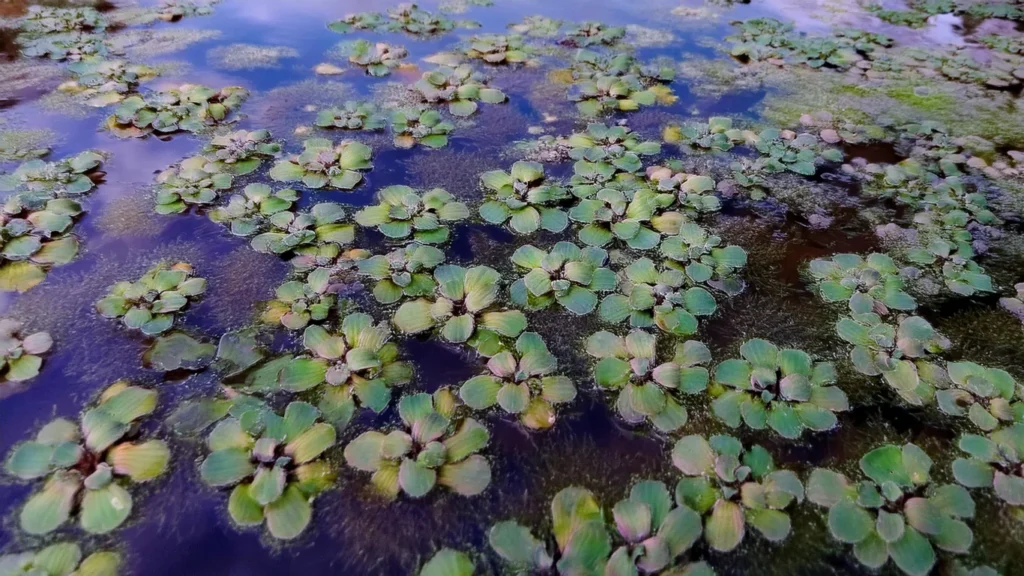
Recommended Tank Size
- Small to Medium Tanks: Salvinia cucullata can be grown successfully in small to medium-sized aquariums ranging from 10 gallons to 50 gallons. In smaller tanks, it’s essential to manage the growth to prevent excessive coverage that may shade out other plants or block light from reaching the lower levels of the tank.
- Large Tanks: In larger aquariums exceeding 50 gallons, Salvinia cucullata can be used to create expansive floating mats or islands, providing shade, shelter, and natural filtration for the aquatic environment. Larger tanks offer more space for the plants to spread and grow without overcrowding.
- Biotope Aquariums and Ponds: Salvinia cucullata is also suitable for use in biotope aquariums or outdoor ponds replicating natural habitats where the plant is found. In these setups, the tank or pond size should reflect the scale of the natural environment and provide ample space for the plants to thrive alongside other aquatic inhabitants.
Suitable Tank Mates
- Fish: Many species of peaceful community fish can coexist harmoniously with Salvinia cucullata. Examples include tetras, rasboras, danios, guppies, mollies, platies, dwarf gouramis, and smaller species of cichlids like Apistogramma. Avoid aggressive or large fish species that may uproot the plants or disturb the floating mats.
- Shrimp and Snails: Dwarf shrimp species such as cherry shrimp and amano shrimp, as well as small snail species like nerite snails and Malaysian trumpet snails, can make excellent tank mates for Salvinia cucullata. They help clean the aquarium by consuming algae and detritus while generally leaving the plants undisturbed.
- Bottom-Dwelling Fish: Fish species that primarily inhabit the bottom region of the aquarium can complement Salvinia cucullata nicely. Corydoras catfish, otocinclus catfish, and small species of loaches like dwarf chain loaches are good options. These fish help with substrate maintenance and add activity to the lower levels of the tank.
- Peaceful Invertebrates: Other peaceful invertebrates, such as freshwater clams and small crayfish species like dwarf crayfish, can coexist with Salvinia cucullata. Just ensure that any crayfish species are small and not aggressive toward other tank inhabitants.
Nutritional Needs
- Macronutrients: Salvinia cucullata requires essential macronutrients such as nitrogen (N), phosphorus (P), and potassium (K) for healthy growth. These macronutrients are essential components of plant tissue and play crucial roles in various physiological processes. Nitrogen is particularly important for leaf growth, phosphorus for root development, and potassium for overall plant health and stress resistance.
- Micronutrients: In addition to macronutrients, Salvinia cucullata requires various micronutrients such as iron (Fe), magnesium (Mg), calcium (Ca), and others. These micronutrients are essential for enzyme function, chlorophyll synthesis, and other metabolic processes within the plant. Iron, in particular, is crucial for preventing chlorosis (yellowing of leaves) and maintaining vibrant green foliage.
- Carbon (CO2): Salvinia cucullata, like all aquatic plants, requires carbon dioxide (CO2) for photosynthesis, the process by which plants convert light energy into chemical energy. While it can absorb CO2 from the water column, supplementing with additional CO2 can enhance growth and overall health, especially in high-light setups.
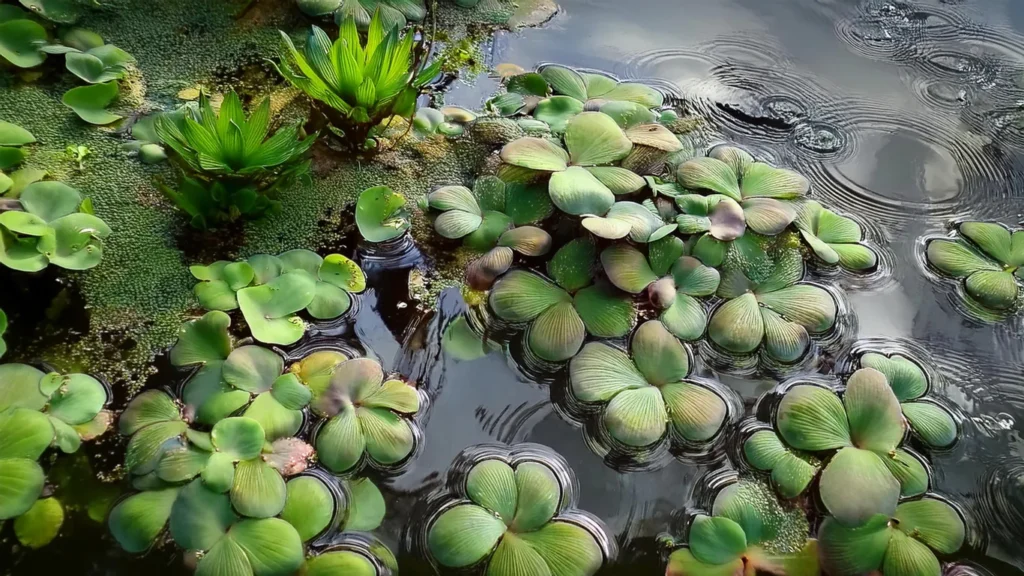
Salvinia Cucullata Cultivation Tips
- Provide Suitable Conditions: They thrives in tropical to subtropical conditions. Maintain water temperatures between 20°C to 30°C (68°F to 86°F) and pH levels between 6.5 to 7.5. Ensure adequate lighting, but avoid direct, intense light that can cause leaf damage or algae issues.
- Nutrient Availability: While Salvinia cucullata can absorb nutrients from the water column, providing a nutrient-rich environment can support healthy growth. Supplement with liquid or dry fertilizers as needed to ensure that essential nutrients, including nitrogen, phosphorus, potassium, and micronutrients, are available.
- CO2 Supplementation: While not always necessary, providing additional CO2 supplementation can enhance growth and overall health, especially in high-light setups. Consider using a CO2 injection system or liquid carbon supplement to boost growth if desired.
- Water Movement: Salvinia cucullata prefers gentle water movement. Ensure adequate surface agitation to prevent stagnation and promote gas exchange. However, avoid strong currents that may dislodge the floating plants.
Plant Propagation Tips
- Natural Reproduction: Salvinia cucullata reproduces primarily through asexual means by producing daughter plants at the nodes of its horizontal stems (stolons). These daughter plants develop into new individuals, forming floating mats or colonies. Allow the plant to propagate naturally by providing suitable conditions for growth and spread.
- Manual Division: You can manually propagate Salvinia cucullata by separating and replanting daughter plants or clusters of plants. Gently separate the daughter plants from the parent plant by carefully pulling them apart at the nodes. Ensure that each division has a portion of the rhizome (horizontal stem) and roots attached.
- Surface Coverage: Spread the separated daughter plants evenly across the surface of the water to encourage new growth and coverage. Ensure that the plants are not overcrowded, as this can lead to competition for nutrients and hinder growth. Allow sufficient spacing between individual plants to promote healthy spread and prevent matting.
- Regular Maintenance: After replanting the daughter plants, continue to provide optimal care and maintenance to promote healthy growth and propagation. Monitor the plants regularly for signs of stress, nutrient deficiencies, or pest infestations, and take appropriate action as needed.
Benefits Of Salvinia Cucullata To Aquatic Ecosystems
- Salvinia Cucullata provides several benefits that contribute to aquatic ecosystems’ overall health and balance. Its dense growth forms a protective canopy on the water surface, offering shade and shelter to a variety of aquatic organisms. This canopy provides a safe habitat for smaller organisms and helps regulate water temperature, preventing extreme fluctuations that could be detrimental to aquatic life.
- Furthermore, Salvinia Cucullata has the capability to absorb nutrients from the water, effectively reducing nutrient levels and minimizing the occurrence of algal blooms. By doing so, it helps maintain water clarity and promotes a healthier environment for aquatic organisms to thrive.
- The dense growth of Salvinia Cucullata can also contribute to the stability of sediment, minimizing erosion and sedimentation in the water body. This is particularly beneficial in areas susceptible to erosion, helping to maintain the overall ecological balance of the ecosystem.
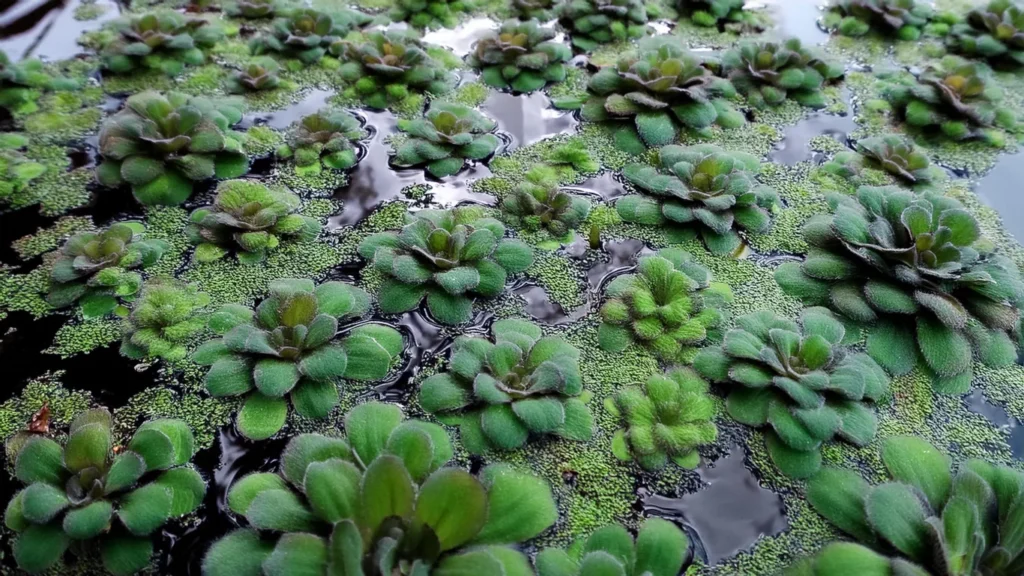
Conclusion
Salvinia Cucullata, an extraordinary aquatic plant, combines captivating beauty with ecological significance.
Understanding its role in aquatic ecosystems and its dual nature as both beneficial and potentially invasive is crucial for maintaining the delicate balance of our precious waterways.
By appreciating the unique physiology and enchanting visuals of Salvinia Cucullata, we can embark on a journey towards its preservation and sustainable management for future generations.
Salvinia Cucullata’s ability to provide shade and shelter for aquatic organisms, reduce nutrient levels, and stabilize sediment showcases its positive influence on aquatic ecosystems.
However, its rapid growth and potential for invasiveness highlight the challenges it poses in non-native habitats.
Therefore, it is of utmost importance to adopt proper cultivation and control methods to prevent detrimental ecological disruptions.
We can implement effective strategies to safeguard Salvinia Cucullata and other endangered aquatic species through collaborative efforts between scientists, conservation organizations, and governmental bodies.
By prioritizing the protection and restoration of natural habitats, establishing protected areas, and preventing the introduction of invasive species, we can ensure the long-term survival of Salvinia Cucullata and preserve the overall health and balance of our cherished aquatic ecosystems.
RELATED: Peacock Moss (Taxiphyllum sp.)Planting And Caring Guide For Beginners
Frequently Asked Questions
What Are The Unique Physiological Characteristics Of Salvinia Cucullata?
Salvinia Cucullata has a floating mechanism that involves water-repellent trichomes on its upper leaf surface.
These trichomes create a layer of air, allowing the plant to float. It also has adaptive features and efficient photosynthetic processes.
What Is The Dual Role Of Salvinia Cucullata In Aquatic Ecosystems?
Salvinia Cucullata provides benefits such as shade, shelter, nutrient reduction, and stabilization of sediment. However, it can also become invasive in non-native habitats, disrupting native ecosystems.
How Can Salvinia Cucullata Be Cultivated And Controlled?
Salvinia Cucullata can be controlled through natural predators and innovative biological control techniques.
Cultivation can be done through natural propagation methods or artificial techniques such as spore collection and division of existing plants.
How Can We Preserve Salvinia Cucullata And Other Endangered Aquatic Species?
Preservation efforts involve the protection and restoration of natural habitats, the establishment of protected areas, and measures to prevent the introduction and spread of invasive species.
How Can Salvinia Cucullata Be Incorporated Into Aquascaping Layouts?
Salvinia Cucullata’s floating nature can create dynamic visual effects. When designing with it, compatibility with other plants and aquatic life should be considered.
- Unveiling The Wonders Of Riccia Fluitans In Aquascapes - August 7, 2024
- Vallisneria Gigantea Var. Guide To Care And Cultivation At Home - July 31, 2024
- Vesicularia Dubyana Care & Growth Guide Tips For Beginner Gardeners - July 30, 2024
